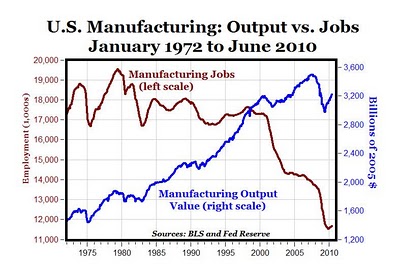Is Automation the Handmaiden of Inequality?
We’ve all heard it before: Americans are more productive than ever, but hourly compensation has stagnated for decades.

The facile explanation for this trend is that we outsourced all our manufacturing jobs. Except that our manufacturing output is higher than ever, and we’re in a dead heat with China for the title of world’s leading manufacturer of stuff.

I’m not arguing that outsourcing isn’t a big factor in this trend – clearly it is – but I’m more interested in another measure of American workers’ changing productivity. Check out what happens when we look at growth in US “Total Factor” productivity since WWII. You’ll notice that it has an inflection point in the early 1970’s, just like the wage growth graph up top.

Total factor productivity “measures any advancement that has been made in how to use existing resources to increase overall output and incomes,” but explicitly does not record changes in productivity due to net increases in the amount of machines or labor in an economy. (There’s more on this measure and its disconnect from IT deployment an earlier post.)
In other words, wage stagnation roughly tracks with stagnation in worker total factor productivity, or productivity minus all those machines and automation we’ve brought on board to make our megacorporations more profitable than ever.
Here’s how I would interpret the odd coincidence of these two trends: in a perfectly capitalist system, increased profit produced by automation flows to the owners of the business. Worker compensation stagnates because, while automation makes each worker more productive, it doesn’t make them any more valuable. While all these machines and IT infrastructure do require a quasi-elite caste of Mandarins to keep them running, on the whole, the skill required of individual laborers has actually gone down.
(Caveat emptor: I’m not an economist. Hit the comments if you have a different interpretation.)
The stagnation of total factor productivity, which is essentially the ability of workers to become more productive independent of machines, shows that US workers are maxed out. In this economy, working harder isn’t going to get you any further along. Education might, if it allows you to climb the value chain and acquire skills for which there is actually a shortage.
What’s interesting is that there are countries in which the productivity / wage disconnect hasn’t occurred, or is less severe. Unlike the UK, Canada and US, France and Italy have seen wages track more closely with productivity. What these countries have in common are strong labor protections and active labor unions. Which suggests that if workers want to claw back part of the value they’ve created, there is no mechanism in a laissez faire economy that will grant it to them.
Keep Reading
Most Popular
Large language models can do jaw-dropping things. But nobody knows exactly why.
And that's a problem. Figuring it out is one of the biggest scientific puzzles of our time and a crucial step towards controlling more powerful future models.
How scientists traced a mysterious covid case back to six toilets
When wastewater surveillance turns into a hunt for a single infected individual, the ethics get tricky.
The problem with plug-in hybrids? Their drivers.
Plug-in hybrids are often sold as a transition to EVs, but new data from Europe shows we’re still underestimating the emissions they produce.
Google DeepMind’s new generative model makes Super Mario–like games from scratch
Genie learns how to control games by watching hours and hours of video. It could help train next-gen robots too.
Stay connected
Get the latest updates from
MIT Technology Review
Discover special offers, top stories, upcoming events, and more.